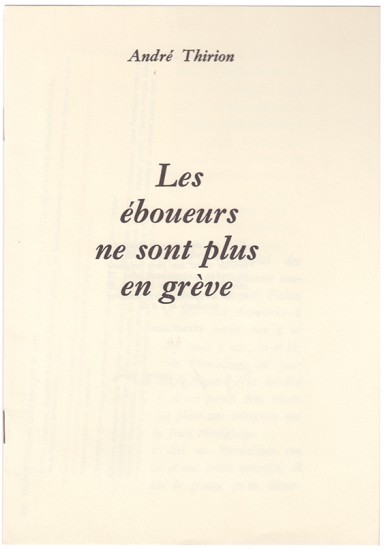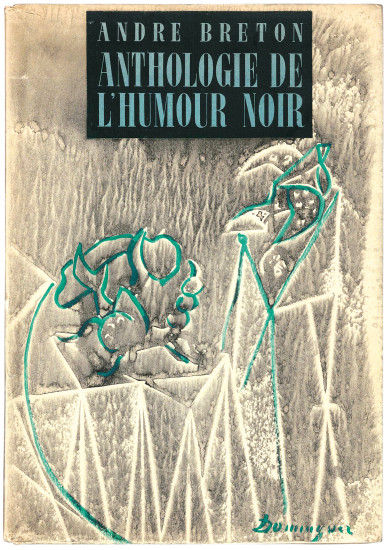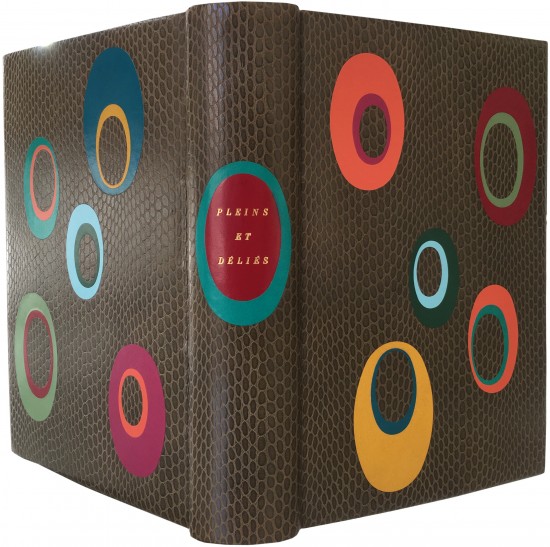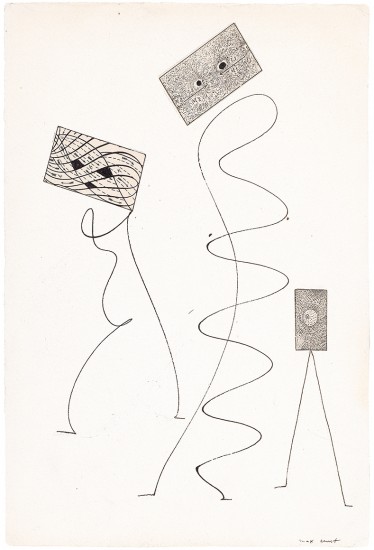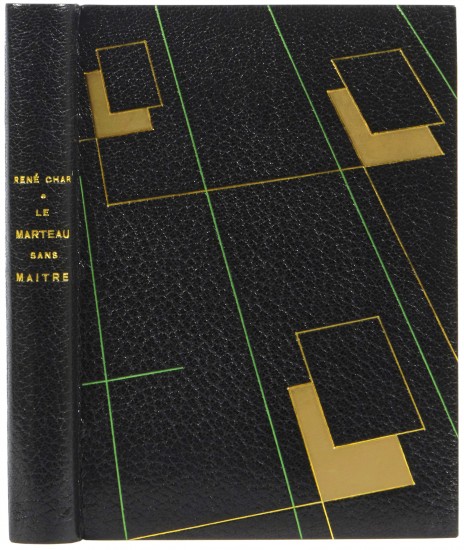kleine dada soirée
Doesburg, Théo van & Kurt Schwitters
(The Hague). 1922 / 1923
An excellent example, never folded, of the first issue of the iconic 'kleine dada soirée' poster.
This programme / poster by Théo van Doesburg and Kurt Schwitters details the events for the travelling show they had devised towards the end of 1922. Their proposed tour of Holland was to start in The Hague in December 1922 but had to be postponed due to problems with Schwitters' passport. On January 10th, 1923, Schwitters and van Doesburg appeared at the Haagsche Kunstkring (the details are at the upper right of the poster together with the address 'Binnenhof 8') and the performance featured van Doesburg's 'dadasofie', 'ragtime-dada' by Erik Satie and Schwitters' sound poetry. The chaotic typography of the poster, in typical dada style, features random capitalisations, variations in typography, the text at variable and peculiar angles, manicules, small vignettes, a quotation from Tristan Tzara etc., all against a background with 'dada' printed in red.
'DADA EXISTE DEPUIS / TOUJOURS LA SAINTE / VIERGE DÉJÀ FUT / DADAÏSTE'. (From the poster).
It is thought that Piet Zwart, a member of the Kunstkring attended that first performance, and over the following three months a further 13 performances were held in different cities. The basic form for each event included van Doesburg reading from his booklet 'Wat ist Dada?', Schwitters making animal noises (barking like a dog or cooing like a dove) from the audience before reading his own works, van Doesburg's wife Nelly - she appeared under the stage name 'Pétro' - would play musical selections and the fourth collaborator, Vilmos Huszár, projected on a screen the moving figure of a mechanical dancer.
'We opened in den Haag in Konstruktixistik manner. Doesburg read a very good dadaistic programme, in which he said the dadaist would do something unexpected. At that moment I rose from the middle of the publik and barked loud. Some people fainted, and were carried out, and the Papers reported that Dada means barking.' (Schwitters quoted in Dada and Surrealism Reviewed).
A second issue of the poster was produced later with the address at upper right ('Haagsche K[unst]. K[ring]. / Binnenhof 8') replaced with details of a subscription for van Doesburg's 'Mécano': 'Abonnement Mécano 5 Fr. per Jaar'.
'DADA EST CONTRE / LE FUTUR DADA / EST MORT DADA / EST IDIOT, VIVE / DADA! DA / DA N'EST PAS / UNE ÉCOLE LITTÉ / RAIRE HURLE. / TRISTAN TZARA'. (From the poster).
'The poster / program 'Small Dada Evening' is a carefully orchestrated visual cacophony. Information is difficult to discern in this nonhierarchical [sic] composition of red and black lettering distributed pell-mell across the white page. The work was printed in two passes through the press ... 'Small Dada Evening' is a tricky piece of graphic design, a playful tease falling somewhere between communication and Dadaist self-subversion. The sheet doubles as a poster advertising the Dada Soirées that toured Holland in 1923 and as a program for the Soirées' proceedings, but even while it claims these dual functions, it undermines them ... 'Small Dada Evening' is not a poster in the traditional sense. It may be better understood as a visual emblem of the Dutch Dada tour, a graphic encapsulation of the soirées and of Van Doesburg's and Schwitters' particular brands of Dada.' (Christian Larsen).
[see 'Dada in the Collection of the Museum of Modern Art', New York, 2008, pp. 102 - 105; see Ades pp. 125 - 126 which describes the series of 'kleine dada soirée' performances (but without naming them) in Schwitters' words].
This programme / poster by Théo van Doesburg and Kurt Schwitters details the events for the travelling show they had devised towards the end of 1922. Their proposed tour of Holland was to start in The Hague in December 1922 but had to be postponed due to problems with Schwitters' passport. On January 10th, 1923, Schwitters and van Doesburg appeared at the Haagsche Kunstkring (the details are at the upper right of the poster together with the address 'Binnenhof 8') and the performance featured van Doesburg's 'dadasofie', 'ragtime-dada' by Erik Satie and Schwitters' sound poetry. The chaotic typography of the poster, in typical dada style, features random capitalisations, variations in typography, the text at variable and peculiar angles, manicules, small vignettes, a quotation from Tristan Tzara etc., all against a background with 'dada' printed in red.
'DADA EXISTE DEPUIS / TOUJOURS LA SAINTE / VIERGE DÉJÀ FUT / DADAÏSTE'. (From the poster).
It is thought that Piet Zwart, a member of the Kunstkring attended that first performance, and over the following three months a further 13 performances were held in different cities. The basic form for each event included van Doesburg reading from his booklet 'Wat ist Dada?', Schwitters making animal noises (barking like a dog or cooing like a dove) from the audience before reading his own works, van Doesburg's wife Nelly - she appeared under the stage name 'Pétro' - would play musical selections and the fourth collaborator, Vilmos Huszár, projected on a screen the moving figure of a mechanical dancer.
'We opened in den Haag in Konstruktixistik manner. Doesburg read a very good dadaistic programme, in which he said the dadaist would do something unexpected. At that moment I rose from the middle of the publik and barked loud. Some people fainted, and were carried out, and the Papers reported that Dada means barking.' (Schwitters quoted in Dada and Surrealism Reviewed).
A second issue of the poster was produced later with the address at upper right ('Haagsche K[unst]. K[ring]. / Binnenhof 8') replaced with details of a subscription for van Doesburg's 'Mécano': 'Abonnement Mécano 5 Fr. per Jaar'.
'DADA EST CONTRE / LE FUTUR DADA / EST MORT DADA / EST IDIOT, VIVE / DADA! DA / DA N'EST PAS / UNE ÉCOLE LITTÉ / RAIRE HURLE. / TRISTAN TZARA'. (From the poster).
'The poster / program 'Small Dada Evening' is a carefully orchestrated visual cacophony. Information is difficult to discern in this nonhierarchical [sic] composition of red and black lettering distributed pell-mell across the white page. The work was printed in two passes through the press ... 'Small Dada Evening' is a tricky piece of graphic design, a playful tease falling somewhere between communication and Dadaist self-subversion. The sheet doubles as a poster advertising the Dada Soirées that toured Holland in 1923 and as a program for the Soirées' proceedings, but even while it claims these dual functions, it undermines them ... 'Small Dada Evening' is not a poster in the traditional sense. It may be better understood as a visual emblem of the Dutch Dada tour, a graphic encapsulation of the soirées and of Van Doesburg's and Schwitters' particular brands of Dada.' (Christian Larsen).
[see 'Dada in the Collection of the Museum of Modern Art', New York, 2008, pp. 102 - 105; see Ades pp. 125 - 126 which describes the series of 'kleine dada soirée' performances (but without naming them) in Schwitters' words].
(300 x 300 mm). Lithograph in red with additional printing in black recto only on thin newsprint paper, the full sheet, never folded; sheet size: 300 x 300 mm.
#48321


